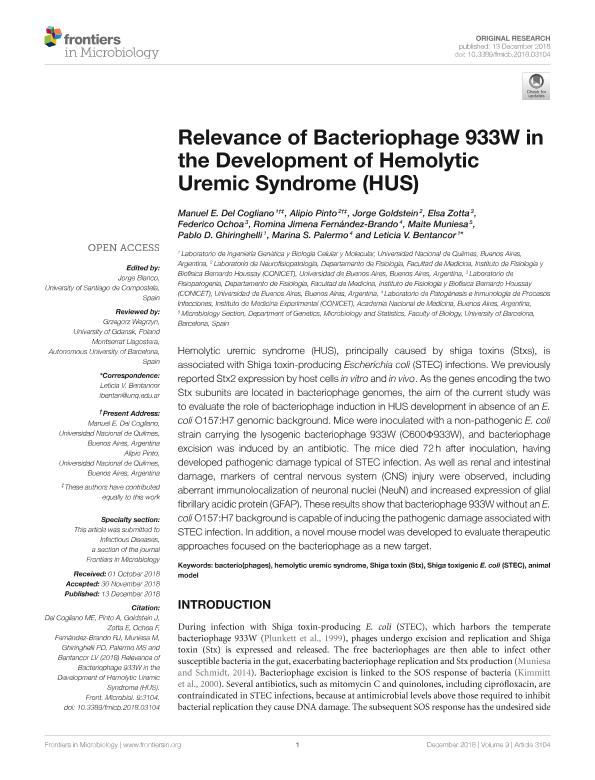Artículo
Relevance of bacteriophage 933W in the development of hemolytic uremic syndrome (HUS)
del Cogliano, Manuel Eugenio ; Vasconcelos Esteves Pinto, Alipio
; Vasconcelos Esteves Pinto, Alipio ; Goldstein Raij, Jorge
; Goldstein Raij, Jorge ; Zotta, Elsa; Ochoa, Federico Claudio; Fernández Brando, Romina Jimena
; Zotta, Elsa; Ochoa, Federico Claudio; Fernández Brando, Romina Jimena ; Muniesa, Maite; Ghiringhelli, Pablo Daniel
; Muniesa, Maite; Ghiringhelli, Pablo Daniel ; Palermo, Marina Sandra
; Palermo, Marina Sandra ; Bentancor, Leticia Verónica
; Bentancor, Leticia Verónica
 ; Vasconcelos Esteves Pinto, Alipio
; Vasconcelos Esteves Pinto, Alipio ; Goldstein Raij, Jorge
; Goldstein Raij, Jorge ; Zotta, Elsa; Ochoa, Federico Claudio; Fernández Brando, Romina Jimena
; Zotta, Elsa; Ochoa, Federico Claudio; Fernández Brando, Romina Jimena ; Muniesa, Maite; Ghiringhelli, Pablo Daniel
; Muniesa, Maite; Ghiringhelli, Pablo Daniel ; Palermo, Marina Sandra
; Palermo, Marina Sandra ; Bentancor, Leticia Verónica
; Bentancor, Leticia Verónica
Fecha de publicación:
12/2018
Editorial:
Frontiers Research Foundation
Revista:
Frontiers in Microbiology
ISSN:
1664-302X
Idioma:
Inglés
Tipo de recurso:
Artículo publicado
Clasificación temática:
Resumen
Hemolytic uremic syndrome (HUS), principally caused by Shiga toxins (Stxs), is associated with Shiga toxin-producing Escherichia coli (STEC) infections. We previously reported Stx2 expression by host cells in vitro and in vivo. As the genes encoding the two Stx subunits are located in bacteriophage genomes, the aim of the current study was to evaluate the role of bacteriophage induction in HUS development in absence of an E. coli O157:H7 genomic background. Mice were inoculated with a non-pathogenic E. coli strain carrying the lysogenic bacteriophage 933W (C600Φ933W), and bacteriophage excision was induced by an antibiotic. The mice died 72 h after inoculation, having developed pathogenic damage typical of STEC infection. As well as renal and intestinal damage, markers of central nervous system (CNS) injury were observed, including aberrant immunolocalization of neuronal nuclei (NeuN) and increased expression of glial fibrillary acidic protein (GFAP). These results show that bacteriophage 933W without an E. coli O157:H7 background is capable of inducing the pathogenic damage associated with STEC infection. In addition, a novel mouse model was developed to evaluate therapeutic approaches focused on the bacteriophage as a new target.
Archivos asociados
Licencia
Identificadores
Colecciones
Articulos(IFIBIO HOUSSAY)
Articulos de INSTITUTO DE FISIOLOGIA Y BIOFISICA BERNARDO HOUSSAY
Articulos de INSTITUTO DE FISIOLOGIA Y BIOFISICA BERNARDO HOUSSAY
Articulos(IMEX)
Articulos de INST.DE MEDICINA EXPERIMENTAL
Articulos de INST.DE MEDICINA EXPERIMENTAL
Articulos(SEDE CENTRAL)
Articulos de SEDE CENTRAL
Articulos de SEDE CENTRAL
Citación
del Cogliano, Manuel Eugenio; Vasconcelos Esteves Pinto, Alipio; Goldstein Raij, Jorge; Zotta, Elsa; Ochoa, Federico Claudio; et al.; Relevance of bacteriophage 933W in the development of hemolytic uremic syndrome (HUS); Frontiers Research Foundation; Frontiers in Microbiology; 9; 3104; 12-2018; 1-11
Compartir
Altmétricas



